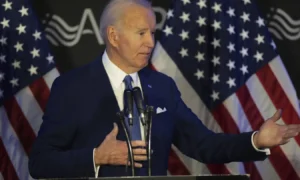President Joseph Biden has been touring the country, touting the job creation benefits of his billions of dollars in clean energy spending.
But, the cutting-edge businesses he promotes face a challenge: finding enough individuals to fill those positions.
The same thriving labour market that has given Biden the lowest unemployment rate since the 1960s is also causing a hiring crunch for the same construction and industrial firms that are essential to his climate plan. Democrats’ policies rely on these firms to manufacture batteries, build solar panels, and speed next-generation technology aimed at removing carbon dioxide from the atmosphere, which causes global warming.
“Having the technicians, engineers, and experienced mechanics, that is going to be a difficulty in the United States,” said Washington Gov. Jay Inslee, a prominent Democratic renewable energy proponent whose own 2020 presidential platform helped shape some of Biden’s plans.
Democrats’ Inflation Reduction Act includes $369 billion in clean energy subsidies designed to send a message to businesses in the United States, pushing them to produce and deploy electric automobiles, carbon-free energy sources, and less-wasteful appliances. And it appears to be effective: According to Climate Power, a coalition of environmental groups, more than 100,000 clean-energy job postings have sprouted up across the United States since Biden signed the climate bill six months ago.
Yet, another source painted a more bleak picture: According to the Bureau of Labor Statistics, the construction business in the United States was 413,000 workers short in December, while the manufacturing sector had 764,000 unfilled positions. According to McKinsey & Co, 550,000 new energy transition positions will be available by 2030, with roughly 10% of them filled by employees quitting the oil and gas business.
“The first thing I heard from everyone was the same thing: We can’t find people to work,” Rep. Bob Latta (R-Ohio) remarked during a recent visit to his manufacturing-heavy district in northern Ohio. “It limits what they can accomplish.”
According to Dawn Lippert, CEO of Honolulu-based Elemental Excelerator, an organisation that assists clean energy start-ups, companies in the clean energy sector have highlighted concerns about workforce shortages.
“Our portfolio companies’ primary issues are money and manpower. “The need for more workers is clear in every industry, from electricians to banking,” she said.
The gap was recognised by the climate law. It contained incentives, such as larger tax credits, for collaborating with registered apprentice programmes, as well as comprehensive support for workforce development to teach individuals to service clean heavy-duty vehicles and heat pumps and to construct clean energy projects. Biden emphasised the idea by visiting a labour union training facility in Wisconsin, his first stop on a manufacturing tour following his State of the Union address, where he referred to the law as “a blue-collar blueprint to rebuild America.”
These expenditures will benefit state leaders who have expressed worry about the pace of workforce development, according to Casey Katims, executive director of the United States Climate Alliance, a bipartisan coalition of 24 governors. States may use the monies to reposition apprenticeship and community college programmes, as they did in the 1990s and 2000s to prepare individuals for computer science employment, he added.
“It is incumbent on all of us to ensure that our labour markets and workforce development systems catch up to the shift and the tremendous possibilities that we are experiencing,” he said.
Carbon management, a new branch of climate technology, issues a warning.
The Biden administration and Congress want to expand the industry, which aims to collect or remove greenhouse gas emissions from fossil fuel combustion. The technology suite would then pump the gas underground, convert it into other products, or use it as a source of lower-carbon hydrogen power. According to scientists, such advances may be required to keep the world from hitting greenhouse gas concentrations that would push it past the brink of catastrophic warming.
McKinsey and digital companies Alphabet, Meta, Stripe, and Shopify bought into the commitment, committing last year to play a “catalytic role” in the development of the carbon removal business. They banded together under the banner Frontier Climate to proclaim that they would help the carbon removal business flourish, in part by committing to buy the climate credits created by such projects.
Frontier Climate also created a searchable database to notify scientists, engineers, and other professionals to possible careers in carbon management. But, when the database was released in November, it found over 100 technical faults that must be resolved before the system can be scaled up.
The simulation also indicated that many of the skills and employees required to store and transport carbon dioxide, such as geologists and pipefitters, are comparable to those used in the oil and gas business – suggesting a possible labour pool.
“Who is the most knowledgeable about the subsurface and burying CO2? “The oil and gas business,” said Ryan Orbuch, a former Stripe employee who is now a partner at Lowercarbon Capital.
“We’re not going to achieve gigatons of carbon removal without employing individuals who already do gigatons of carbon movement,” he continued. “Those people exclusively work in oil and gas firms right now since those are the only companies that do this.”
Anu Khan, director of science and innovation at Carbon180, a carbon removal advocacy firm, believes that in order to avoid a labour shortage in the future, cleantech industries must begin informing workers with comparable skills in other industries about the opportunities available in clean energy now. She stated that the industry requires trade union members’ talents in areas such as pipeline fitting to carry carbon dioxide, drilling wells to store carbon dioxide, and engineering to design and operate machines.
“We haven’t yet completely faced that difficulty, but it’s on the horizon,” she said of the labour shortage.
Khan is attempting to bring the business together with labour unions and tradesmen. The connections are occasionally overt: Roxanne Brown, vice president at large of the Union Steelworkers, sits on Carbon180’s board of directors.
“These investments will be very beneficial in protecting jobs in the industrial sector, as well as making it more sustainable and globally competitive,” Anna Fendley, director of regulatory and state policy for the United Steelworkers, said on a call with reporters on Jan. 26.
While it is uncertain how many jobs the carbon removal business could create, climate researchers have predicted that one component known as direct air capture could provide significant advantages. (Instead of a specific power plant or industrial, this early-stage technology would remove greenhouse gases from the environment.)
According to climate research firm Rhodium Group, for every megaton of carbon dioxide that a direct air plant can remove each year, the technology will generate approximately 1,500 temporary jobs and 500 permanent jobs for continuous operations. For every gigatonne, this might convert into 1.5 million construction and 500,000 operation jobs. According to the World Resources Institute, direct-air capture at 0.5 gigatonnes of CO2 removal per year would sustain a more modest 139,000 operational jobs.
According to scientists, the world will need to remove 10 gigatonnes of CO2 each year by 2050 in order to keep the earth from warming 1.5 degrees Celsius beyond pre-industrial levels, the super-ambitious goal set by the Paris climate agreement.
“When we talk about gigaton scale, we’re talking about a trillion or trillions of dollars that this business will make up,” said Whitney Herndon, associate director at Rhodium and the report’s author. “Our job projections frequently elicit the intuitive reaction, ‘Whoa, that’s a lot of jobs.’ But I believe that is due to a fundamental misunderstanding of the size of this industry.”









